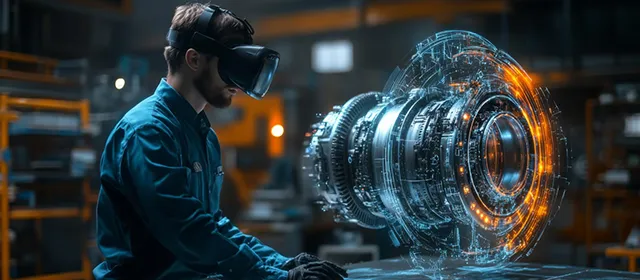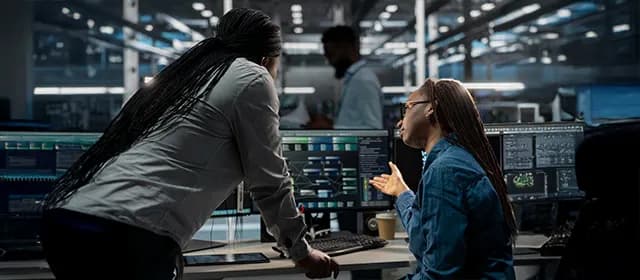Three-dimensional (3D) vision is fundamental to enabling advanced autonomy and safe collaboration in robotic systems. Autonomous mobile robots (AMRs) and collaborative robots (cobots) require high-fidelity spatial perception in order to operate reliably in complex or dynamic environments. Conventional two-dimensional vision permits object recognition, but lacks accurate depth estimation.
The adoption of stereo-vision, depth cameras and structured-light sensors provides richer point-cloud data, enabling robust navigation, precise manipulation and human-aware interaction.
Kings Research estimates that the global 3D machine vision market is projected to grow from USD 3.75 billion in 2025 to USD 7.91 billion by 2032, exhibiting a CAGR of 11.24% over the forecast period. This report explores how 3D vision technologies support AMRs and cobots, reviews key enabling modalities, highlights real-world use cases, examines leading providers, and evaluates challenges and future directions.
Why Are Robotics Adoption Rates Still Low Across Industries?
National measurement and policy institutions are highlighting the potential and hurdles in deploying robotics technology broadly. The National Institute of Standards and Technology (NIST) runs a “Robotic Systems for Smart Manufacturing” program that defines performance metrics, test protocols and measurement science required to assess robotic capabilities in manufacturing contexts. The program observes that only approximately 10 percent of potential users have adopted robotics systems (Source: www.nist.gov).
The U.S. Census Bureau’s 2023 Annual Business Survey reports that robotics adoption remains relatively limited among businesses (Source: www.census.gov). This data suggests that while robotics is growing, many firms have not yet integrated advanced automation. NIST’s own research further notes that manufacturers face substantial barriers. Its 2024 NIST GCR report identifies capital costs, integration issues and lack of in-house expertise as major adoption constraints (Source: nvlpubs.nist.gov).
What Are the Key 3D Vision Modalities Used in Robotics?
Robotic systems rely on multiple 3D sensing modalities to generate depth and spatial information. Stereo-vision uses pairs of cameras to triangulate matching features and form dense depth maps. RGB-D cameras (combining colour and depth sensing) typically rely on time-of-flight (ToF) or structured-light techniques to produce point-cloud data.
Each modality has trade-offs in terms of range, resolution, frame rate, latency and environmental robustness. Stereo-vision is strong in environments with sufficient texture but can struggle when surfaces lack features or lighting is weak. ToF sensors directly measure distance but can suffer in very bright or very dark scenes. Structured-light sensors perform well at short to moderate range but may degrade under ambient interference. Sensor selection often depends on the application’s operational envelope, computational budget and dynamic constraints.
Role of 3D Vision in Autonomous Mobile Robots (AMRs)
Autonomous mobile robots navigate warehouses, factories and other complex industrial spaces. Real-time depth perception enables obstacle detection, path planning and reactive avoidance. Orbbec, a provider of 3D vision systems, has integrated its Gemini 330 series stereo-vision cameras into the NVIDIA Isaac Perceptor platform for AMRs, enhancing depth perception even in unstructured environments.
These depth sensors support mapping of the environment, creation of cost maps for navigation, and detection of unexpected obstacles such as pallets, drop-offs or people. The availability of synchronized multi-camera setups permits 360-degree coverage, reducing blind spots and enhancing safety.
How Do AMRs Maintain Depth Perception in Harsh Conditions?
AMRs must operate in varied lighting and terrain conditions, including dusty warehouses or outdoor yards. 3D vision cameras that combine active illumination and passive sensing can maintain depth fidelity across such conditions. For example, Orbbec’s Gemini 335Lg, launched at ROSCon 2024, includes a serializer interface (GMSL2) and a robust connector (FAKRA) to deliver reliable depth data in rugged mobile environments.
This design enables AMRs to maintain depth perception while moving over uneven surfaces, through electromagnetic environments, and over long cable lengths, enabling reliable performance in enterprise-scale deployments.
Why Is 3D Vision Essential for SLAM and Precise Localization?
Simultaneous localization and mapping (SLAM) benefits greatly from dense depth data. Stereo-vision systems generate rich point clouds that can be fused with odometry and inertial measurement unit (IMU) data to create accurate maps and robust localization. This capability enables AMRs to localize in GPS-denied environments, adapt to layout changes, and operate dynamically.
How Does 3D Vision Enable Reliable Grasping and Bin Picking?
Cobots handling logistics and manufacturing tasks often need to pick randomly arranged parts from bins. Structured-light or stereo 3D vision systems provide point-cloud data that informs grasp planning. Zivid’s structured-light 3D camera, the Zivid 3, offers high-definition RGB and depth data, with millimetre-level accuracy even for shiny, transparent or black objects.
The high resolution and fast capture of such sensors enable cobots to scan bin contents rapidly, compute grasp poses, and manipulate objects reliably. This is especially valuable for inventory handling, piece-picking, and mixed-SKU warehouse automation.
- Quality Inspection and Pose Verification: Cobots equipped with 3D vision can perform dimensional inspections, detect surface defects and verify part orientation. Depth data allows comparison against CAD models, enabling automated detection of deviations or missing features. Using such feedback, robots can adaptively re-orient parts, signal errors or perform corrective actions, improving product quality.
- Safe Human–Robot Interaction: In shared workspaces, cobots must sense human presence and predict motion to avoid collisions. Depth sensors provide real-time spatial awareness, enabling robots to modulate speed or pause when humans enter their workspace. Fusing colour, depth and motion data supports intent inference, giving robots context to safely collaborate with human workers on assembly, material handling or maintenance tasks.
- Precision Docking and Automated Service Tasks: Some robotics applications require precise alignment for tasks such as automated charging, tool handover or fluid transfer. 3D vision enables robotic arms to identify target interfaces in three dimensions, compute pose and execute docking. Orbbec’s integration with NVIDIA Isaac Perceptor via the Perceptor Developer Kit (OPDK) demonstrates such capability: the kit includes multiple synchronized Gemini 335L depth-plus-RGB cameras and Jetson AGX Orin compute to support complex visual tasks.
Who Are the Key Providers Advancing 3D Vision for Robotics?
Orbbec stands out as a pioneer in 3D vision for robotics. Its Gemini 330 camera series, integrated with NVIDIA Isaac Perceptor, supports depth reconstruction and cost map generation in real time. The company has also launched the Gemini 335Le, a stereo vision camera with Ethernet connectivity designed for industrial robots.
Another provider, Zivid, develops structured-light 3D cameras optimized for robot manipulation tasks. Its Zivid 3 XL250 model supports large working volumes and delivers high-fidelity depth and colour data at millimetre accuracy. This gives robots strong spatial awareness over extended range, enabling tasks such as depalletizing or bin-picking in large-scale automation.
Orbbec also continues to expand its product range. The company recently introduced the Gemini 435Le stereo vision camera and the Pulsar ME450 dToF LiDAR at ROSCon JP 2025 and Logis-Tech Tokyo 2025. These products highlight the company’s ongoing investment in high-performance 3D sensors for collaborative and mobile robotics.
What Strategic Advantages Does 3D Vision Bring to Robotics?
Three-dimensional vision improves autonomy by delivering precise spatial data, which reduces the risk of collision, enhances mapping and increases the reliability of navigation in dynamic or unstructured environments. Depth perception offers cobots robust object recognition, facilitating adaptive grasping and quality control that surpasses simple 2D imaging.
Enhanced situational awareness promotes safer human–robot interaction. Robots equipped with 3D vision can detect human presence, predict motion and adjust behaviour accordingly, leading to smoother collaboration and higher operational throughput. On the operational side, 3D vision allows for markerless navigation, reducing the need for physical infrastructure modifications such as floor markings or tape.
Low-latency depth processing is also beneficial for real-time control. Sensors that include onboard depth computation (for example, Orbbec’s Gemini series) offload compute work from the main processor. This frees computational resources for localization, planning and AI inference. The reduction in compute burden enables smaller, more efficient robot systems.
Scalability represents another major advantage. Modular 3D vision systems with synchronized multi-camera setups produce global coverage for large robots or multi-robot fleets. Engineers can deploy a common vision stack across both AMRs and cobots, simplifying integration, calibration and maintenance.
What Challenges Limit the Adoption of 3D Vision in Robotics?
Three-dimensional vision introduces significant engineering challenges. Point-cloud generation and depth processing produce large volumes of data that demand compute resources and impose latency constraints. Robotic developers need efficient algorithms, calibration workflows and edge inference to ensure real-time performance.
Some 3D modalities do not perform well in adverse conditions. Stereo-vision can deteriorate in low-texture or reflective environments. ToF sensors may suffer from multi-path effects or limited accuracy at long range. Structured-light systems may not operate effectively under strong ambient light or over long distances.
Calibration and synchronization of multiple sensors, including cameras, IMUs and wheel odometry are complex and require robust systems. Such calibration must remain stable under vibration, temperature change and movement, which is particularly challenging in mobile robots.
Reliability and safety remain central concerns. Vision systems must be tolerant of sensor failure, misalignment or environmental interference. Failure in perception can result in navigation error or unsafe behaviour, especially in human-populated environments.
Adoption costs and technical complexity pose barriers for some firms. The NIST GCR report identifies cost, lack of domain expertise and integration risk as major deterrents for small and medium manufacturers. Many potential users may lack robotics engineers or sufficient budget to deploy advanced 3D vision.
Outlook
Edge computing and embedded AI will drive future improvements. Onboard inference will become more common, reducing latency and eliminating dependence on external compute or cloud services. Emerging architectures may integrate depth estimation, motion prediction and semantic understanding into a unified pipeline.
Hybrid perception systems are likely to proliferate. Robots may combine stereo, ToF, LiDAR and structured-light sensors to maximize redundancy and environmental coverage. Such systems will permit robust perception across lighting conditions, range scales and terrain types.
Advances in large-scale calibration and automatic sensor fusion will be critical. Calibration workflows that self-correct over time will allow robots to maintain accurate depth perception even under changing conditions. Standardized SDKs and APIs will reduce integration cost and support faster adoption.
From a strategic perspective, continued collaboration between 3D camera makers, compute-platform providers and robot OEMs will accelerate innovation. Partnerships such as Orbbec with NVIDIA Jetson reflect this trend. Open platforms, modular hardware and reference designs will lower entry barriers and democratize 3D vision for a wider range of robotics developers.
Conclusion
Three-dimensional vision is reshaping the capabilities of both autonomous mobile robots and collaborative robots. High-fidelity depth perception enables safer navigation, accurate manipulation and more intelligent human-robot interaction. Sensor providers such as Orbbec and Zivid are delivering advanced depth cameras designed for industrial and mobile applications.
Government research institutions such as NIST highlight both the promise and the barriers to deployment, underscoring issues of cost, adoption and performance. Overcoming these challenges will require further innovation in embedded AI, sensor fusion and cost-effective calibration. The convergence of 3D vision, compute platforms and robotic architectures is enabling a more capable, flexible and intelligent generation of robots that can operate autonomously and collaboratively across factories, logistics centres and shared human spaces.




